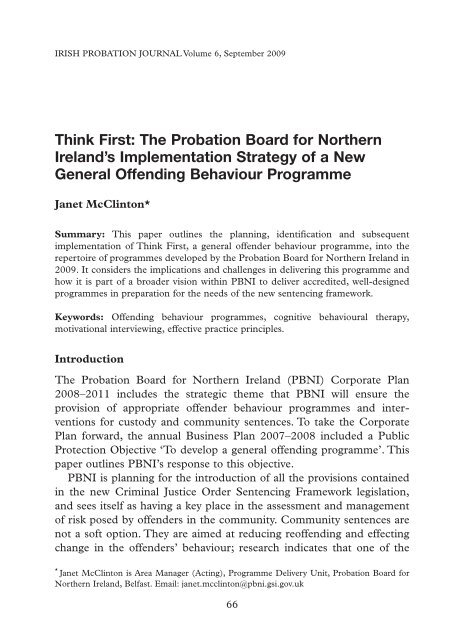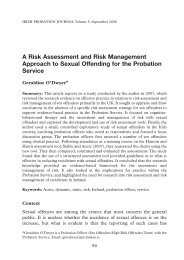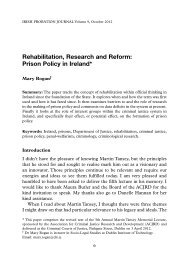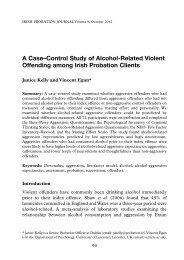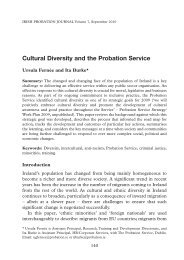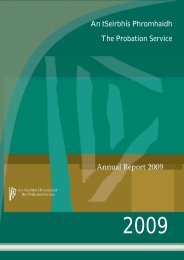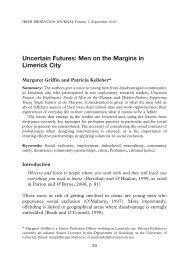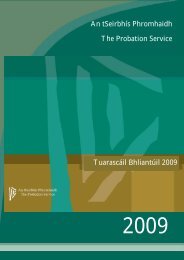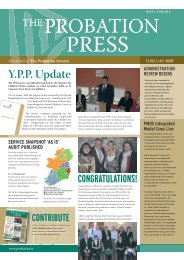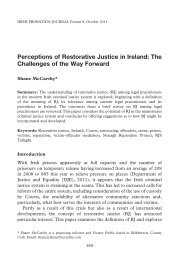IPJ Vol. 6 body_IPJ Vol. 5 No. 1 - The Probation Service
IPJ Vol. 6 body_IPJ Vol. 5 No. 1 - The Probation Service
IPJ Vol. 6 body_IPJ Vol. 5 No. 1 - The Probation Service
- No tags were found...
Create successful ePaper yourself
Turn your PDF publications into a flip-book with our unique Google optimized e-Paper software.
IRISH PROBATION JOURNAL <strong>Vol</strong>ume 6, September 2009Think First: <strong>The</strong> <strong>Probation</strong> Board for <strong>No</strong>rthernIreland’s Implementation Strategy of a NewGeneral Offending Behaviour ProgrammeJanet McClinton*Summary: This paper outlines the planning, identification and subsequentimplementation of Think First, a general offender behaviour programme, into therepertoire of programmes developed by the <strong>Probation</strong> Board for <strong>No</strong>rthern Ireland in2009. It considers the implications and challenges in delivering this programme andhow it is part of a broader vision within PBNI to deliver accredited, well-designedprogrammes in preparation for the needs of the new sentencing framework.Keywords: Offending behaviour programmes, cognitive behavioural therapy,motivational interviewing, effective practice principles.Introduction<strong>The</strong> <strong>Probation</strong> Board for <strong>No</strong>rthern Ireland (PBNI) Corporate Plan2008–2011 includes the strategic theme that PBNI will ensure theprovision of appropriate offender behaviour programmes and inter -ventions for custody and community sentences. To take the CorporatePlan forward, the annual Business Plan 2007–2008 included a PublicProtection Objective ‘To develop a general offending programme’. Thispaper outlines PBNI’s response to this objective.PBNI is planning for the introduction of all the provisions containedin the new Criminal Justice Order Sentencing Framework legislation,and sees itself as having a key place in the assessment and managementof risk posed by offenders in the community. Community sentences arenot a soft option. <strong>The</strong>y are aimed at reducing reoffending and effectingchange in the offenders’ behaviour; research indicates that one of the* Janet McClinton is Area Manager (Acting), Programme Delivery Unit, <strong>Probation</strong> Board for<strong>No</strong>rthern Ireland, Belfast. Email: janet.mcclinton@pbni.gsi.gov.uk66
Think First 67most effective ways to bring about change can be through the offenderundertaking a structured programme. <strong>The</strong>se programmes, run with atight management structure, by skilled staff and with a programmemanual, have been shown to be effective (Maguire, 1995).In order to ensure that the most effective programme was identified, aworking party was set up and spent some considerable time researchinggeneral offending behaviour programmes. This scoping exercise looked atvarious general offending behaviour programmes in the UnitedKingdom, including Reasoning and Rehabilitation, One to One andEnhanced Thinking Skills.Following analysis of national and international research, PBNIdecided to implement the Think First programme. This is a Home Officeaccredited programme delivered in most probation areas in England andWales. Evaluation studies conducted in 2006/07 showed a very promisingimprovement in positive changes in behaviour among offendersundertaking the programme (Hollis, 2007).One of these studies looked at a significant number of offenders whoattended General Offending Behaviour Programmes, and the studyindicated that the reconviction rate for those who completedprogrammes fell by 26%. However, in relation to those who started butfailed to complete, this number reduced dramatically, indicating the needfor appropriate targeting and selection of participants.To reflect back to the Corporate Plan, it included the need for thedevelopment of a <strong>No</strong>rthern Ireland Offender Management Strategywhich in a nutshell dealt with the need for a seamless offendermanagement process from court sentence through prison, into thecommunity until the end of the court disposal; this has become knownwithin PBNI as ‘End to End offender management’. This allows for analignment of processes and systems to ensure the risk management ofoffenders. One of the main attractions of Think First is that it can be runin the prison and in the community: this was seen to be an importantpart of the decision-making as to its suitability to meet the needs ofPBNI.<strong>The</strong>oretical baseThinking areas targeted by offending behaviour programmes includeself-control, cognitive style, interpersonal problem-solving, socialperspective-taking, values and critical reasoning.
68 Janet McClintonIn deciding on Think First, a major factor was that it was based oneffective practice principles, which incorporate the following:• appropriate selection and allocation• community-based• focused on criminogenic needs• structured approach• responsivity• programme integrity• clear theoretical framework• cognitive behavioural methods.It is important to understand the theory of cognitive behavioural therapy(CBT) on which the programme is based. Professor James McGuire wasresponsible for developing Think First, and it is his view that cognitivebehaviourism represents a combination of different psychologicalapproaches, behaviourism and cognition: the former focuses onobservable behaviour and the latter focuses on subjectivity. CBT focuseson thoughts, feelings and behaviour and how they interact with eachother. Cognitive abilities are viewed as learned rather than inherent, andso the ability to change and develop new learning is possible.Groupwork facilitation within PBNI is based on the principle of prosocialmodelling. An important factor in group facilitation is the belief inthe importance and effectiveness of programmes. This enables clearercommunication of the programme contents to participants.A complex dynamic exists between facilitators and group participants,and it is essential that an empathetic relationship be established betweenthe two. <strong>The</strong> facilitator is a role model who is clear about roles andboundaries; within this the participant feels respected and valued and bycopying the facilitator can learn appropriate ways of behaving.Think First programme overview<strong>The</strong> Think First programme is an intensive offence-focused groupworkprogramme delivered to groups of up to 10 offenders. Its aims are:• to help group members develop their skills for thinking aboutproblems and for solving them in real-life situations• to apply these skills to the problem of offence behaviour and helpgroup members reduce the risk of future offending.
Think First 69<strong>The</strong> main objective of the programme is to help offenders learn new skillsrelated to social problem-solving that will enable them to manage areasof concern in their lives and to avoid further offending. It tackles the wayoffenders think and behave and aims to change behaviour by teachingproblem-solving skills.<strong>The</strong> programme runs for 30–32 two-hour sessions, comprising fourpre-group, 22 group and seven post-group sessions with a number ofsessions delivered immediately after the groupwork element by the CaseManager. <strong>The</strong> final sessions can be delivered over some three to fourmonths after completion of the group element, acting as a ‘booster’ orused as a relapse prevention module.<strong>The</strong> pre-group sessions establish a point of contact and set thescene for the remainder of the <strong>Probation</strong> Order. <strong>The</strong>y begin theworking alliance and also check out any obstacles to successfulcompletion. <strong>The</strong> use of motivational interviewing skills is essential at thisearly stage.<strong>The</strong>re are five principles of motivational interviewing: expressempathy; avoid argumentation; develop discrepancy; support selfefficacy;and roll with resistance. Motivational interviewing is based onthe principles of CBT and is a client-centred approach, which aims tohelp the participant see the possibilities that can be gained by change.Core components of the Think First programme include socialproblem-solving skills, which are the focus of sessions 1–13 (session 14is a review session). <strong>The</strong>se early sessions start with problem awareness,gathering information, problem definition and assessment, offendingbehaviour as a problem, through to alternative thinking and decisionmaking.A number of criminogenic factors are targeted by these skills,i.e.:• not recognising or avoiding problems• impulsivity• lack of empathy• inability to think of consequences• rigid thinking.After session 14 the sessions are all about applying the skills learnt. Skillsin self-management and self-control are addressed in sessions 15 and 16;examples of the criminogenic factors targeted include addictivebehaviours and impulse control.
70 Janet McClintonSocial behaviour and interaction skills are looked at in sessions 17 and18; examples of the criminogenic factors targeted include communica -tion styles, assertiveness skills and cognition patterns, e.g. stereotyping.Sessions 19–21 focus on perspective-taking, attitudes, negotiation andconflict resolution. Session 22 is a review session.Pre- and post-groupwork sessions are conducted by the case managersand these include preparation for engaging in the programme and relapseprevention strategies.Target group<strong>The</strong> Think First programme can only be undertaken by way of additionalrequirement to a <strong>Probation</strong> Order. A full assessment of the offender’ssuitability and motivation to comply with the demands of the programmeshould be conducted at the Pre Sentence Report stage and consentobtained. <strong>The</strong> following criteria are the basic indicators of suitability forthe programme and can be evidenced through the PBNI assessment toolACE, which is a dynamic offender management assessment tool:1. 3+ previous convictions2. aged 18+3. medium-/high-risk offenders, i.e. 16+ on final ACE score4. those who have a score of 2 or 3 out of sections 8:3 and 9:4 ACE –Personal Section.<strong>The</strong> programme may not be appropriate for certain categories ofoffenders as outlined below, and additional suitability assessments maybe required.Research shows that for an offender to benefit from the programme itis important that they are motivated to attend and complete. Offenderswho start the programme and don’t complete are more likely to reoffendthan offenders who don’t start the programme at all, therefore selectionand targeting of appropriate offenders for this programme is key.Most suitable• those aged roughly 18–40 years• medium to medium-high risk of reoffending and high scoring in the‘individual characteristics/ personal skills’ section of ACE, i.e. 16+• repetitive offenders
Think First 71• burglary, theft, criminal damage, driving-related behaviours• some offenders convicted of assault• evidence of difficulty in problem-solving linked to offendingbehaviour.Least suitable• sex offenders, schedule one offenders• mentally disordered offenders• those with learning difficulties• domestic violence, substance misuse• those at low risk of re-offending.Treatment managementTreatment management is an essential component of accreditedprogrammes. One of the Treatment Manager’s primary responsibilities isproviding support and guidance to programme facilitators in achievingbest practice for ongoing programme sessions. <strong>The</strong> Treatment Manageralso needs to ensure that programme integrity is maintained throughoutall aspects of delivery, to act as a drift check and ensure that there is noreversal of the aims of the programme.Finally, the Treatment Manager will assist and support facilitators tomake decisions, in consultation with the programme manager, withregard to the day-to-day running of the programme, particularly wheredifficult practice issues arise.EvaluationAs part of the need to ensure consistency, accredited programmes mustevidence that they are being evaluated. In case of Think First this is doneby the application of psychometric tests pre- and post-programme, asfollows.• Impulsivity Scale (Eysenck and Eysenck, 1978)• Locus of Control (Craig et al., 1984)• Gough Socialisation Scale (Gough, 1960)• Crime PICS II (Frude et al., 1994)• PICTS (Psychological Inventory of Criminal Thinking Styles)(Walters, 2001)• Social Problem-Solving Questionnaire (Clark, 1988)
72 Janet McClinton<strong>The</strong> psychometric tests can provide information on the impact ofprogrammes in terms of changes in the offender’s attitudes and selfreportedbehaviour both throughout and immediately after attending aprogramme. <strong>The</strong> information from pre- and post-testing will alsocontribute to long-term studies into reconviction and reoffending rates.AccreditationTo achieve accredited status, programmes go through a rigorous processin terms of how they are designed and developed, and are scrutinised toensure that they can evidence an impact on offenders. In addition, theprogramme has to evidence programme integrity, i.e. that it is beingdelivered to a standard that ensures it targets criminogenic need andleads to a reduction in reoffending.Implementation planHaving decided on the appropriate programme it was necessary toestablish an implementation plan, and consultation with the NationalOffender Management <strong>Service</strong> (NOMS) led us to opt for a widespreadimplementation across the service and judiciary within a six-monthtimescale. <strong>The</strong> strategy had to include senior management agreementand so a presentation was made to and agreed by senior managementwithin PBNI.<strong>The</strong> strategy outlined the following.• It was recommended that Think First should replace two of thecurrent range of programmes: Disqualified Drivers Programme(DDP) and Don’t Risk It Programme (DRIP).• In line with the suggested model of programme delivery that had beenagreed with the NI Prison <strong>Service</strong>, it was recommended that PBNIshould deliver the Think First accredited programme according to therelevant level of assessed risk of harm.• A timeline was drawn up that included training needs for staff acrossthe whole service, and this was seen as a key factor in embedding theprogramme into staff thinking.• Awareness training was seen as being required for external agenciesincluding courts, magistrates and judiciary. Consultation withjudiciary entailed a briefing note being drawn up to be sent out to
Think First 73judges/magistrates, followed up by meetings between individual AreaManagers and the courts sitting within their area; a meeting was alsoheld with the President of the presiding magistrates and there wasongoing attendance at Judicial Studies Boards.<strong>The</strong> strategy also looked at the area of offenders who posed risk of harm.PBNI has a range of programmes for perpetrators of sexual offences anddomestic violence, which are delivered by a specialist team in Belfast andfrom a number of locations in the rural areas. <strong>The</strong> Cognitive Self ChangeProgramme is delivered from a central point in Belfast using a genericteam approach with trained facilitators based in outer offices. Offenderswhose offending behaviour is of a sexual and/or domestic violence naturerequire services that are delivered and managed tightly and that staff betrained and supported to ensure a very high level of performance. <strong>The</strong>development and implementation of new accredited programmesincluding the Internet Programme for Sex Offenders and the IntegratedDomestic Abuse Programme (IDAP) as well as the Safer LivesProgramme (programme for young men who commit sex offences)will increase the need for high-intensity programmes for high-riskoffenders to be delivered using a specialist model of delivery andmanagement.<strong>The</strong> strategy recommended that programmes for medium/high-riskconcern offenders should also be delivered using a specialised teamapproach similar to that employed at the Intensive Supervision Unit(ISU). <strong>The</strong> ISU was set up to be staffed by experienced <strong>Probation</strong>Officers who have received specialist training in working with thistargeted group of offenders. A cohort of staff provides group workprogrammes and case management for offenders who have been deemedat risk of harm. <strong>The</strong> programmes offered there include the CommunitySex Offenders Groupwork programme (CSOGP) and the MenOvercoming Domestic Violence programme (MODV). <strong>The</strong>refore, toreplicate this necessitated the training of a cohort of staff who coulddeliver the Think First programme aimed at medium- to high-riskoffenders.Workforce planningA statistical analysis of PBNI caseload revealed that between 250 and300 offenders fell into the target group of:
74 Janet McClinton• adult 18+• male/female• not a sex offender/domestic violence offender• medium/high risk, i.e. 16+ in the Assessment Case management andEvaluation (ACE) score• personal/thinking skill deficits – Section 9:4 (ACE).It was estimated that PBNI should aim for approximately 200completions per year on a basis of 10–12 participants per group.This meant that PBNI needed to commence two groups per month,one Belfast-based and one rural-based. Each group would continue forthree months at a rate of two sessions per week. In terms of dosage theideal was two half-day sessions interspaced by one to two days. However,it was agreed that in the rural areas these sessions could be combinedinto a one-day format.It was suggested that the grade of staff used to deliver low- to mediumintensityprogrammes be employed to deliver the Think Firstprogramme, i.e. <strong>Probation</strong> <strong>Service</strong> Officer (PSO) grades with sessionalback-up to cover other programmes. This grade of staff were recruited toprovide direct service delivery to offenders and were expected to carry amixed workload for example programme delivery, community projectsand duties in court or as required. Experience of working in social care,youth and community work with a qualification in one of these was oneof the essential criteria.Staff ratios were outlined to meet the requirements to deliver theThink First Programme: seven PSO staff in the rural areas and 5.5 in theBelfast Area.It was estimated that approximately 50% of clients were employed,requiring the delivery of evening programmes on a 50% pro-rata basiswith day programmes. As a result it was suggested that some staff mightneed to be employed on a part-time, evening basis.TrainingTraining was competence-based, requiring the use of an assessmentcentre approach. <strong>The</strong> assessment centre is structured around acompetency framework that is the basis of assessing the suitability of astaff member to attend core skills and programme-specific training; thepurpose is to ensure staff members’ ability to deliver an accreditedprogramme.
Think First 75<strong>The</strong> process involved a 10–15 minute presentation and a structuredinterview lasting approximately 40 minutes. This approach had alreadybeen employed successfully for other accredited programmes that PBNIdelivers.Once selected, facilitators were required to attend five days’Groupwork Skills Training and a further five days’ programme-specifictraining. PBNI identified and employed two experienced trainers fromthe <strong>No</strong>rth West Training Consortium in February and March 2008 totrain an initial cohort of 16 staff, i.e. Facilitators and Programme/Treatment Managers.Training for pre-sentence report (PSR) writers and Case Managers aswell as Field Managers was highlighted. <strong>No</strong>rth West TrainingConsortium Trainers provided two-day ‘Train the Trainer’ training forthree to four Learning and Development staff and the ProgrammeManagers so that they can provide this training in-house on a cascadebasis.As noted in the overview, evaluation will be a key part of thedevelopment of this programme and a database has been set up; withinthis <strong>No</strong>rthern Ireland has been designated as a separate region byNOMS. <strong>The</strong> information from the psychometric tests will be fed into thenational database, which is set up in such a way that PBNI can use thedata collected. It is equally important to gather the views of participantsin terms of its responsivity in terms of delivery but also in terms ofrelevance to their needs. This information is being gathered throughverbal feedback, interviews and group discussions. A total of 180<strong>Probation</strong> Orders have been made with the additional requirement ofThink First across <strong>No</strong>rthern Ireland. Ten programmes have been run todate, with an average of nine people completing each programme.Evaluation feedback will be available within the next six to 12 monthsand it will be important to use this information to feed into thedevelopment of this programme.Future development<strong>The</strong> main aim of Think First and the development of programmes is toensure effective risk management of offenders, to challenge, change andprotect.<strong>The</strong> Think First programme was implemented in <strong>No</strong>rthern Ireland in2008 and is thus relatively new to the PBNI; however, it has been
76 Janet McClintonrunning in England and Wales since 2004. Like all programmes it is notstatic, and while research has shown the efficacy of the programme therehas been ongoing updating to reflect developing practice. Within PBNIwe are watching with interest the development of a new secondgenerationprogramme, ‘Thinking Skills’, which incorporates advances incognitive behavioural techniques.ReferencesBest, P., Rodgers, B. and McClinton, J. (2007), Implementation Plan for Think First,Belfast: <strong>Probation</strong> Board for <strong>No</strong>rthern IrelandClark, D.A. (1985), Impulsiveness and Psychomotor Abilities in Adult Offenders inRelation to Early Onset of Delinquency, DPS Report Series II, no. 140, London:Home Office, Prisons DepartmentCraig, A.R., Franklin, J.A. and Andrews, G. (1984), ‘A Scale to Measure Locus ofControl of Behaviour’, British Journal of Medical Psychology, vol. 57, pp. 173–180Eysenck, S.B. and Eysenck, H.J. (1978), ‘Impulsiveness and Venturesomeness, <strong>The</strong>irPosition in a Dimensional System of Personality Description’, PsychologicalReports, vol. 43, no. 3, 1247–1253Frude, N., Honess, T.M. and Maguire, M. (1994), Crime-PICS II: A Psychometric Toolfor Measuring Attitude Change in <strong>Probation</strong> Clients. See www.crimepics.co.uk/index.htmlGough, H. (1960), ‘<strong>The</strong>ory and Measurement of Socialisation’, Journal of ConsultingPsychology, vol. 24, no. 1, pp. 23–30Hollis, V. (2007), NOMS RDS APS Study, London: Ministry of Justice, England andWalesMaguire J. (ed.) (1995), What Works: Reducing Re-offending: Guidelines from Researchand Practice, Chichester, UK: WileyUnderdown, A. and Ellis, T. (1998), Strategies for Effective Offender Supervision: Reportof the HMIP What Works Project, London: HM Inspectorate of <strong>Probation</strong>Walters, G.D. (2001), <strong>The</strong> Psychological Inventory of Criminal Thinking Styles, version4 manual. Psychological <strong>Service</strong>s, SPS


